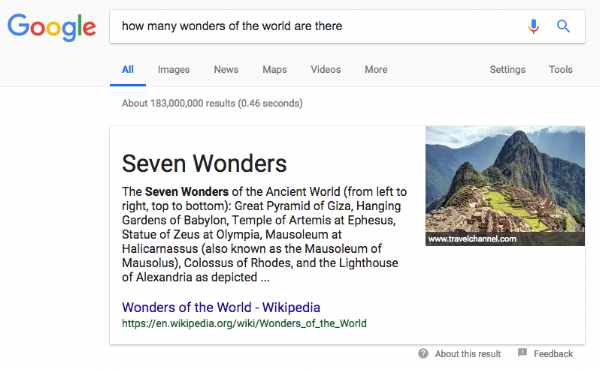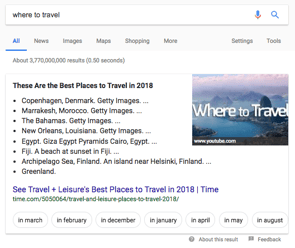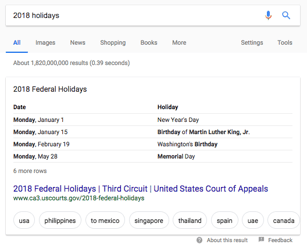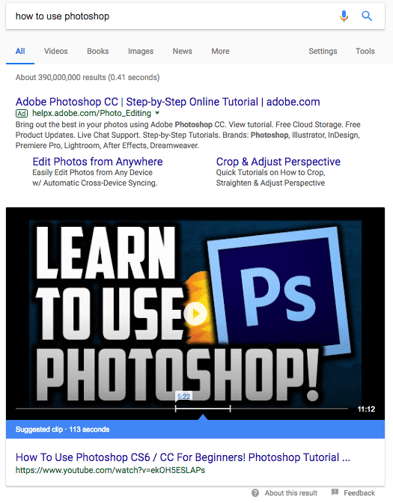Whether you’re new to blogging or have been blogging for some time, there’s always room for improvement.
Google’s incorporation of featured snippets on a search engine results page provides a whole new way for you to optimize your content.
There’s a lot of information out there regarding featured snippets, so I’ve put together a quick list to cover what you really need to know when putting together your content or historically optimizing old content.
4 Things To Know About Google’s Featured Snippets
What is a Featured Snippet?
Featured snippets are an organic search feature that Google started implementing on pages in 2016 (they were previously called "quick answers," which first launched in 2013.)
A snippet is one piece of content that has been called out in a box and appears on the first page of the Google search, normally above other content.
Snippet’s essentially help answer questions – keep this in mind when creating your content.
For example, when you type in “How many wonders of the world are there?” you’ll see the below snippet featured.

Why It’s Important to Try to Rank For Google’s Featured Snippets
For us inbound marketers, a huge way we aim to increase organic traffic to our websites is through blogging.
In short, we spend a lot of time doing keyword research around words we want to rank for and then writing information packed blog posts around those words. That used to be good enough, but now, it’s just not.
Google’s ever-changing algorithm keeps us on our toes, and if we don’t try to optimize our content for Google’s search engine, unfortunately a lot of our efforts could go to waste.
HubSpot’s found that on SERPs with no featured snippet, the first result brings in about 33% of the total clicks. The second brings in 18%, and the rest, 11% or under. However, when the SERP has a featured snippet, that snippet gets about 50% of the clicks.
TLDR: If your post appears on a page that contains a featured snippet, the majority of people reaching that page won’t even give your post the time of day.
How to Choose the Right Featured Snippet Medium
Trying to win a featured snippet for a keyword that already has one can sometimes work in your favor.
Since there is already a snippet being pulled on that page, a lot of legwork has been done for you. You now know how in which format Google thinks the answer to a question pertaining your keyword should be delivered.
Your job is to now make sure your content is presented in the right medium (text, video, or list and table snippet) and then optimize your content to be even better than your competition's!
If you’re trying to win a featured snippet for a page that doesn’t have one yet, you’ll want to think through the kind of question your content helps to answer and then ensure that the medium you deliver that content in will be the most beneficial for your audience.
List Featured Snippet Table Featured Snippet

 Video Featured Snippet
Video Featured Snippet
How to Format Blog Posts for Featured Snippets
With blog posts being a main medium in which websites push out constant content, I wanted to highlight a few quick tips for optimizing formatting.
In order for Google to pull your content for search engine pages, it needs to be able to read what is actually on your page. In order to help out Google’s algorithm that is specific for featured snippets, you’ll want to do three things:
- Make sure your code is clean. Strip your copy of any font weights, spacings, etc. that are unnecessary and making your code messy.
- Use your H tags properly.
- Use H1 tags for the main page title of your blog article.
- Use H2 tags in your body copy to break up different sections of your article.
- Use H3 tags for any subheadlines. So if you’re writing a blog post that’s a list, each list item will use an H3 tag.
Note: Speaking of lists, Google loves lists (code = <li>) and paragraphs (code = <p>).
H tags are a great way to appease Google’s algorithm and make your content easier to read for Featured Snippets since the content you formatted with H2 and H3 tags are typically the content that get pulled into the featured snippet.

While it may seem like featured snippets typically pull content from blog pages, there’s no reason they can’t pull an actual page from your website.
Optimizing a website page for Google’s featured snippets is the same as that of a blog (or other medium).
However, since website pages can be more intricate in design, just ensure that you’re not compromising a user’s experience on the page just to try and rank for a snippet – after all, that would defeat the whole purpose!


Ryanne Doumet